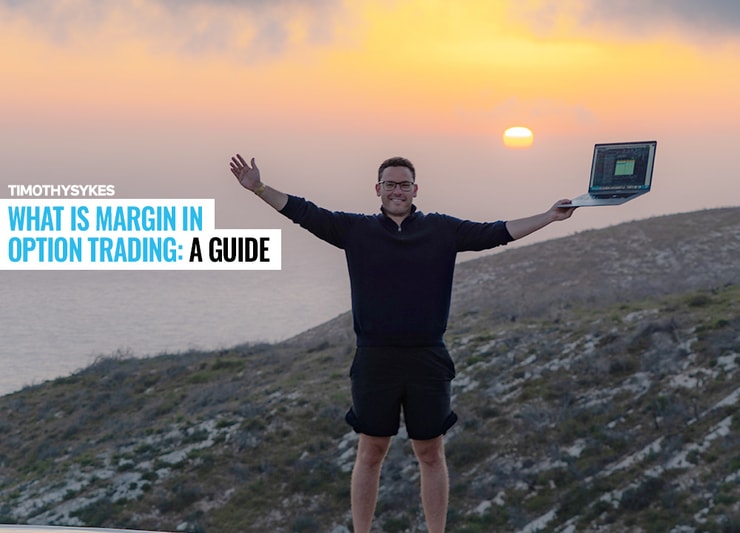Margin in options trading refers to the cash or assets needed by brokers as collateral. You need to submit this margin as collateral if you want to write or sell options.
Options margin is especially important for more complex options strategies. But that doesn’t mean beginners can’t benefit from learning about it. Remember, it never hurts to build your knowledge account.
Let’s dive in!
Table of Contents
What Is Margin in Options Trading?

Margin in options trading is the collateral you need to write or sell options. This collateral can be in the form of cash or underlying securities for the options you write.
The Financial Industry Regulatory Authority (FINRA) sets minimum options margin requirements. Options exchanges may also set their own rules.
Brokers might have extra margin requirements on top of the ones that the regulators and exchanges set.
Not all options writing needs a margin. Strategies like covered puts and calls don’t have required margins. They don’t need margins because you have to own the underlying stock before using the strategy.
Beginner options traders don’t need to be concerned with margins yet. Most brokerage services start beginner traders at Level 1 trading clearance. Level 1 traders only have access to the most basic of options strategies that don’t require margins. When they reach Level 2 and beyond, they might need to have a margin trading account to use certain strategies.
There’s no two ways about it: options margins can get complicated. Complex options strategies like strangles and straddles need you to calculate multiple margins.
Margin requirements will also impact your trading plan. You might lose more if a trade doesn’t go your way, just as your profits may have a more rapid trajectory.
Learning options trading lingo is one of the first steps to becoming a smart trader. Check out my guides on swing trading, strike prices, and spread option trading.
Options Trading vs Margin Trading

Options trading and margin trading are two very different things.
Options trading requires margin loans for some strategies. Margin trading refers to trading stocks with money loaned from the brokerage.
Options trading and margin trading have similarities and differences. Let’s go over their similarities first:
- Both trading methods can provide a higher rate of returns than regular trading.
- Their loss potential can also be greater.
- Both trading methods need extra approval from your brokerage.
What are the differences between options trading and margin trading?
- Margin trades require a margin loan from your brokerage. Options trading doesn’t need you to take a loan.
- Margin trades increase your asset buying power directly. Options trading increases your buying power indirectly. It’s indirect because options give you the ability to trade a stock at a more desirable price.
I don’t trade options — I leave it to pros like tech entrepreneur and trader Ben Sturgill. His smart-money webinars are the product of more than 2 decades of experience in the market and a unique technology, and they’re well worth checking out.
More Breaking News
- BioVie Inc. Surge: Insightful Opportunities or Pricey Peril?
- SOUN Shares Plummet: Time to Buy or Cut Losses?
- Smurfit WestRock’s Stock Spike: What Happened, and What’s Next?
Check out the webinar here to see why Ben’s smart-money scanner has been going haywire lately!
How to Avoid Option Margin Requirements
You can avoid options margin requirements by choosing options strategies that don’t rely on margin. Some beginner strategies, like long puts and long calls, don’t have margin requirements.
You can also work around margin requirements on these strategies:
- Covered puts and calls: Covered puts and calls require you to own the underlying stock. That means you don’t need to submit the shares as margin.
- Debit spreads: In a debit spread, you buy and sell options of the same class (i.e., either calls or puts) for the same asset. The option you buy is more valuable than the one you sell in this strategy, offsetting the obligation of the option you sell with the right to exercise the option you buy. The end result is that you don’t need a margin at all.
The more experienced you are, the more options strategies you’ll have access to. Read my article on option trading levels to learn more.
How to Calculate Margin for Option Trading

Margin amounts differ for each trading strategy. Different brokerage firms also require different margins. This means it’s hard to pin down an exact formula to calculate the margin for all kinds of options trades.
The Chicago Board of Options Exchange (CBOE), however, does a pretty damn good job. They provide a calculator for margin requirements. You can also check their Margin Manual to learn more about the initial margin requirements for various trades.
I’ve said before that margin requirements can be broker-specific. Some brokerage firms provide margin calculators to help you determine margin costs.
These calculators are tuned to each broker’s requirements. That’s why they’re likely the best way to calculate margin.
Different brokers offer different benefits for traders. Check out my guide to the best brokerage firms for options trading.
Key Takeaways

Options margin is cash or assets you need to deposit before selling options. How much margin you need to deposit depends on the option type and regulator decisions. Some exchanges also require an extra deposit on top of what’s mandated by regulatory bodies.
Beginner traders don’t need to worry about option margins. They’re rarely found in basic options strategies.
As traders learn and level up their trading approval, they’ll start encountering margin requirements. Most traders encounter options margin requirements when they reach Level 2 trading clearance.
If you don’t want to trade with margin — wise choice — you can work around it with some strategies. Covered trades and debit spreads don’t require any margin deposits.
You can profit from options trades with or without a margin. The key is designing a strategy that fits your unique goals and temperament.
Having a good mentor helps. In the options world, I think there’s no better mentor than Ben Sturgill.
Check out Ben Sturgill’s smart-money webinars — they’ve been killing the market lately!
Did that clear up your questions on options margin? Let me know about your experiences in the comments!


Leave a reply